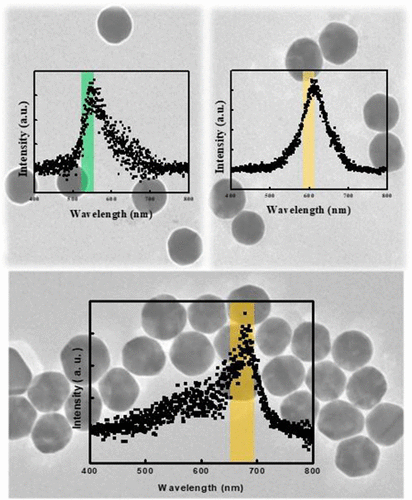当前位置:
X-MOL 学术
›
Bioconjugate Chem.
›
论文详情
Our official English website, www.x-mol.net, welcomes your
feedback! (Note: you will need to create a separate account there.)
Activated Plasmonic Nanoaggregates for Dark-Field in Situ Imaging for HER2 Protein Imaging on Cell Surfaces.
Bioconjugate Chemistry ( IF 4.0 ) Pub Date : 2020-01-23 , DOI: 10.1021/acs.bioconjchem.9b00787 Yingshu Guo 1, 2, 3, 4 , Fei Liu 1 , Yinhua Hu 1 , Xiaofei Zheng 1 , Xiuping Cao 1 , Yanxi Zhu 3 , Xiaoru Zhang 2 , Dongjiao Li 1 , Zhenhua Zhang 1 , Si-Kai Chen 4
Bioconjugate Chemistry ( IF 4.0 ) Pub Date : 2020-01-23 , DOI: 10.1021/acs.bioconjchem.9b00787 Yingshu Guo 1, 2, 3, 4 , Fei Liu 1 , Yinhua Hu 1 , Xiaofei Zheng 1 , Xiuping Cao 1 , Yanxi Zhu 3 , Xiaoru Zhang 2 , Dongjiao Li 1 , Zhenhua Zhang 1 , Si-Kai Chen 4
Affiliation

|
Dark-field microscopy (DFM) based on localized surface plasmon resonance (LSPR) was used for observation of experimental phenomena, which is a hopeful nondamaging and non-photobleaching biological imaging technique. In this strategy, plasma nanoaggregates with stronger scattering efficiency were formed in the presence of the target, causing a "turn-on" phenomenon, when asymmetry modified AuNPs were introduced as probes with zero LSPR background. First, Au1-N3 probe and Au2-C≡C probe were designed for the cycloaddition between azide and alkyne to form AuNP dimers under catalytic action by Cu+, which was obtained from the reduction of Cu2+ by sodium ascorbate. The two kinds of probes were successfully used for the detection of Cu2+ in rat serum. Then, to apply this concept to protein on cells, DNA and antibody were modified on the probes. DNA1/Au1-N3 probe and anti-HER2/Au2-C≡C probe were proposed for HER2 protein DFM on cells. By designing an aptamer sequence in primer, the rolling circle amplification (RCA) was introduced in HER2 DFM on cells, and the image signal was much brighter than that from no-RCA. The unique design made it easier to discriminate the target signal from background noise in cell DFM. This method might be used in the fields of molecular diagnostics and cell imaging.
中文翻译:

活化的等离子纳米聚集体,用于在细胞表面进行HER2蛋白成像的暗场原位成像。
基于局部表面等离振子共振(LSPR)的暗场显微镜(DFM)被用于观察实验现象,这是一种有希望的无损且无光漂白的生物成像技术。在这种策略中,当将不对称修饰的AuNPs作为零LSPR背景的探针引入时,在目标存在下会形成具有较强散射效率的等离子体纳米聚集体,从而引起“开启”现象。首先,设计了Au1-N3探针和Au2-C≡C探针,用于在叠氮化物和炔烃之间通过Cu +催化作用形成AuNP二聚体,这是通过抗坏血酸钠还原Cu2 +而得到的。两种探针已成功用于大鼠血清中Cu2 +的检测。然后,为了将此概念应用于细胞上的蛋白质,对探针上的DNA和抗体进行了修饰。提出了DNA1 / Au1-N3探针和抗HER2 /Au2-C≡C探针用于细胞HER2蛋白DFM的研究。通过设计引物中的适体序列,将滚动环扩增(RCA)引入细胞的HER2 DFM中,图像信号比无RCA的图像信号亮得多。独特的设计使区分单元DFM中的目标信号和背景噪声变得更加容易。该方法可能用于分子诊断和细胞成像领域。
更新日期:2020-01-24
中文翻译:

活化的等离子纳米聚集体,用于在细胞表面进行HER2蛋白成像的暗场原位成像。
基于局部表面等离振子共振(LSPR)的暗场显微镜(DFM)被用于观察实验现象,这是一种有希望的无损且无光漂白的生物成像技术。在这种策略中,当将不对称修饰的AuNPs作为零LSPR背景的探针引入时,在目标存在下会形成具有较强散射效率的等离子体纳米聚集体,从而引起“开启”现象。首先,设计了Au1-N3探针和Au2-C≡C探针,用于在叠氮化物和炔烃之间通过Cu +催化作用形成AuNP二聚体,这是通过抗坏血酸钠还原Cu2 +而得到的。两种探针已成功用于大鼠血清中Cu2 +的检测。然后,为了将此概念应用于细胞上的蛋白质,对探针上的DNA和抗体进行了修饰。提出了DNA1 / Au1-N3探针和抗HER2 /Au2-C≡C探针用于细胞HER2蛋白DFM的研究。通过设计引物中的适体序列,将滚动环扩增(RCA)引入细胞的HER2 DFM中,图像信号比无RCA的图像信号亮得多。独特的设计使区分单元DFM中的目标信号和背景噪声变得更加容易。该方法可能用于分子诊断和细胞成像领域。











































 京公网安备 11010802027423号
京公网安备 11010802027423号